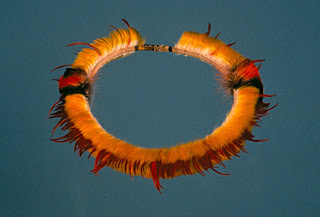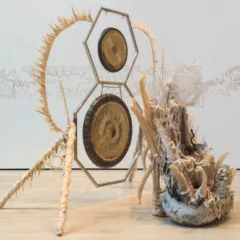
Richard Hodges, the Williams Director of the Penn Museum
The University of Pennsylvania Museum of Archaeology and Anthropology (previously known to its friends as The University Museum, but now called The Penn Museum) is one of the great collections of its kind. While its location at South and 33rd Streets, at one edge of Penn’s campus, makes it easy to access by car, train, subway, trolley and bus, it suffers from the fact that it’s neither on the way to anyplace else nor at the top of a hill on a major urban axis, as the PMA is. That’s just one of the challenges facing its new director, Richard Hodges, a distinguished archaeologist, author of ten books and formerly director of the Prince of Wales Institute of Architecture, London, the British School in Rome and most recently, the Institute of World Archaeology at the University of East Anglia.
I took the opportunity to talk with Hodges in early December, and he warned that he wasn’t yet at the museum full-time, so his responses were provisional. Who does he think the Penn Museum’s audience is? A good part are academic peers, students, and a large number of school children; another part are people attending events (where the organizer has rented part of the museum). I acknowledged that the Penn Museum presented imaginative programs for children and families, but wasn’t sure that visitors like myself, a non-specialist adult, were being served as well. Hodges said that was a fair concern and one they were looking at. Perhaps the museum has been too exclusively academic; academics tend to be too wordy … we have wonderful, wonderful material and we don’t present it as well as we might.

The objects illustrated here are some of the new director’s favorites so far. Dating from the late 19th century, this Bearskin Shaman’s Robe is a rare example of a type of object used by a member of the Bear Society (an animal dreaming society known among northern Plains Indian groups, whose members were known for their curing abilities). Photo: Penn Museum
Noting that Hodges had created a gallery for contemporary art at the British School, does he see a place for artists at the Penn Museum? I do, was his immediate response. He’d love to do programs with the ICA. He’s also thought a lot about the way a number of British museums have worked with artists, juxtaposing their work with earlier collections. I’m personally very fond of installations, he said; acknowledging that some are more successful than others, the whole point of them is to be challenged in some way. I mentioned that other Philadelphia institutions, such as the American Philosophical Society and the Philadelphia Society for the Preservation of Landmarks had recently begun to invite artists in to respond to their collections. Hodges is sympathetic to that idea. He brought up Cornelia Parker as an artist who’s done interesting work with museum collections; I noted that her exhibition had been at the ICA and like him, I admired her work greatly.
The museum’s vision statement, cited on the website, mentioned the goal of making archaeology and anthropology relevant to contemporary issues. Did he have examples? Two different levels, he answered. At an exhibition level he pointed to Surviving the Body of Evidence, which opens in April and looks at evolution — a very pertinent national issue, we both agreed. At a larger context he referred to the fact that from its beginnings the museum had made places in the world (such as Ur) through its excavations. Ur was made between the British Museum and this museum, as a construct. As place-makers the museum has to understand those places and what their needs are for the community in the 21st century. He mentioned training local people at the various research sites as a way to contribute to those communities.

Granite sphinx, dating to 1279-1204 BCE, is the third largest known and weights about twelve tons. It was buried up to its shoulders; only the exposed head was eroded by windblown sand. Photo: Lauren Hansen-Flaschen.
Since he had brought up Ur it seemed appropriate to raise the question of what the museum might do if Iraq were ever settled enough to pay attention to its ancient past and request the return of those objects – what would the Penn Museum do? After all, Penn and the British Museum own many of their most important objects; and the question might well come up with many of the museum’s other collections. Repatriation is an issue, and we are dealing with that. I think we’re an exemplar with the North American situation; we’ve given back material to native groups. How the trustees would look at the issue with objects from outside the U.S. I don’t yet know. He said he is certain that it’s a priority to digitize such collections, so they would be available to any school child in Bagdad. We’ve got to move beyond our post-colonial anguish and begin to confront the issues in an appropriate way. But that requires huge sums of money.

The museum has various needs that require big budgets, and Hodges will be spending his first three months reviewing them and developing a plan to meet them. He has the university’s support and, from what I hear, he’s been enthusiastically welcomed by the museum’s staff. The Penn Museum has extraordinary collections, is involved in ongoing research around the world, and its staff has amazing skills and accomplishments. One curator regularly lectures the military on archeological concerns in war zones; another has published a book on Johnny Depp. As a long-time fan of the museum, I’m excited to see what the new director will do. Hodges has the academic gravitas to direct a major museum’s growth and the charm to pull off his plans.
Anyone who wants to hear about Richard Hodges’ past research will have a chance on Feb. 19 at 6pm, when he’ll be giving a lecture on his 14 years’ of excavations at Butrint, an ancient, medieval, and Ottoman Empire town on the Straits of Corfu in southern Albania. The lecture is free, but reservations are recommended: 215/898-4890.









